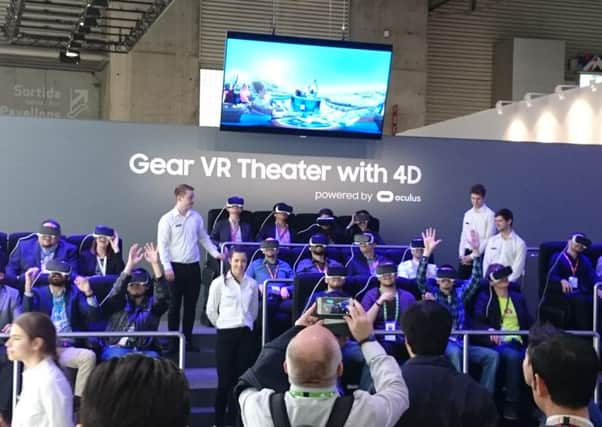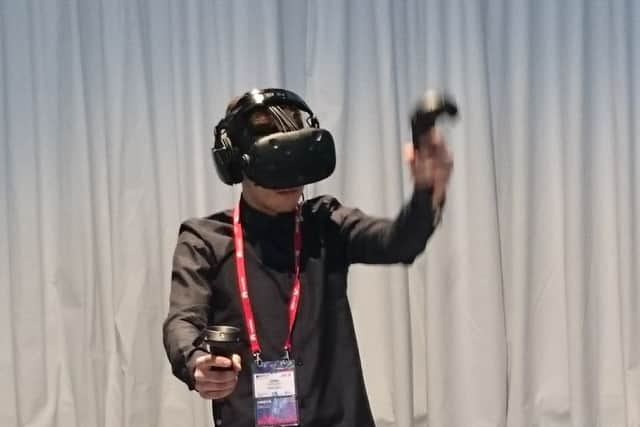Ben Hutton: Virtual reality first hand at the Mobile World Congress 2016


Or so it would seem if you were attending the Mobile World Congress (MWC) in Barcelona. In no less than three different locations you are encouraged to sit down, strap in, and put your hands in the air like you just don’t care.
This is my first time at the MWC. The venue – the Fira Gran Via (mainly) – is approximately nine times the size of Glasgow’s SECC; as such it took me over an hour just to walk the periphery of the event!
Advertisement
Hide AdAdvertisement
Hide AdThere is a multitude of sources for what new phones/wearable technologies were announced, but I’ll sum it up for you: the phones have better processors, better cameras, and better batteries. Also, get practicing pronouncing Chinese brands Xiaomi (shh-ow-me) and Huawei (wah-way) as they have a significant presence here.


Wearables are no longer the new kids on the block so at MWC they are largely lighter or sparklier (fashion brand Guess has a range of smartwatches) and wearables now connect to shoes or scales or, well, something.
As for virtual reality (VR), it’s inescapable, and like most I found myself standing in a queue for a shot of the Samsung Gear Theater. This involved sitting in one of three rows of chairs, putting on the headset, and being put through your paces on a virtual rollercoaster.
The chairs move – which seems, frankly, like a bit of a cheat. Much of the feeling of movement and changing speed is delivered through the seats. The actual environment isn’t styled like a real rollercoaster. Instead, it is a fast-moving rush of candy-coloured shapes and at the end you feel a bit sick.


I should say that I am not immune to the surface charms of VR. As a child I recorded every Cyberzone, the virtual reality series of the early nineties hosted by Craig Charles, and the experience felt a bit like what I had seen then… in the early nineties.
Eleswhere, the HTC Vive is a substantial piece of kit – and at a launch price of $799 (about £570) I suppose it would need to be. In the demos you use the peripherals it comes with to shoot at targets, like other arcade games of the nineties. And if it seems that I am trivialising the immense engineering effort that has gone into creating an at-home VR experience, it is only because it is trivialising itself.
The truth about the potential for VR is far greater than what is being shown in these demos. Take, for example, the simple way we look at information – be it on paper, or on a screen. The size of these, whether it be A4 paper or a 13” monitor have come from manufacturing decisions, not the optimal way to absorb information. Imagine learning when data can be displayed in terms of relative depth and inter-relationships can be visualised in three dimensions.
With VR, the quality of your school wouldn’t have to be linked to your real, physical location. We could look through the eyes of another person, see how they live their life. With VR e-health and medical telemetry could be transformed. But sure… theme-park rides are good too.
Advertisement
Hide AdAdvertisement
Hide AdIt is a shame that the glitzy, sparkly new gadgets seem to have garnered all the media attention so far, because very little of the exhibition space is devoted to that. As you walk around, you start to see a preponderance of (often gigantic) stands that look like there are selling rocket packs (I’m afraid it turns out they are definitely not) and offer to solve things like “small-cell back-haul problems”. I have to admit that I did not know what “small-cell” or “back-haul” was a reference to, or that it was a problem. But it is, and they are solving it, to give us smart cities and 5G.
I know, I know, many of us don’t have 4G yet, but the change to 5G is more than just a “speed bump” – it’s a way to a truly connected society, which is, according to Vodafone chief executive Vittorio Colao, “a gigabit society”. The jump comes not just from the boost to bandwidth (how much data you use), but the impact of latency (the gap between performing an action and it appearing on a screen).
A gigabit society has latencies of less than 1 millisecond – so, in short, real time. The foundations of all of this are being laid (sometimes literally) now by people at MWC; the problems of connecting everything to the internet (and rest assured that’s the plan) are being solved in conversations around me. Those versions of VR are a more likely reality than you think; they aren’t something that will be possible in 20 years’ time but, albeit in part, in just a few years.
So the HTC Vive might be getting most of the media coverage but what’s actually happening in the background is far more exciting. We are approaching the top of a far more exciting rollercoaster.
• Ben Hutton is client services director at mobile apps developer xDesign
